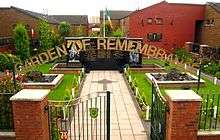Falls Road, Belfast
Falls Road (from Irish túath na bhFál, meaning 'territory of the enclosures'[1]) is the main road through west Belfast, Northern Ireland, running from Divis Street in Belfast city centre to Andersonstown in the suburbs. The name has been synonymous for at least a century and a half with the Catholic community in the city. The road is usually referred to as the Falls Road, rather than as Falls Road. It is known as the Faas Raa in Ulster-Scots.[2]
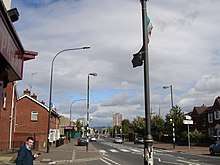 Falls Road looking towards Divis flats and the city centre | |
 Shown within Greater Belfast | |
| Native name | Bóthar na bhFál (Irish) |
|---|---|
| Maintained by | Belfast City Council |
| Length | 1,600 m (5,200 ft) |
| Location | Belfast, Northern Ireland |
| Postal code | BT12 |
| Coordinates | 54.59347°N 5.95823°W |
| Northeast end | Divis Street |
| Southwest end | Andersonstown Road |
| Other | |
| Known for | Numerous murals, Irish republican community |
History
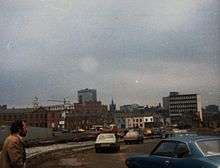
The Falls Road derives its name from the Irish túath na bhFál, an Irish petty kingdom whose name means "territory of the enclosures".[1] This territory was roughly the same as that of the ecclesiastical parish of the Shankill, which spanned a large portion of modern-day Belfast.[1]
The Falls Road itself was originally a country lane leading from the city centre but the population of the area expanded rapidly in the 19th century with the construction of several large linen mills. All of these have now closed or have been repurposed. This original area, which was centred on the junction of modern-day Millfield and College Avenue on what is now Divis Street, was known as Falls and lent its name to the road.[3] which had previously been called The Pound.[4] The housing in the area developed in the 19th century and was organised in narrow streets of small terraced housing. The Westlink linking the M1 and M2 motorways now cuts through this area.
The short stretch of road linking Divis Street to the city centre is known as Castle Street after the original Belfast Castle which was built nearby by the Normans in the 12th century. Near the bottom of Castle Street is located Chapel Lane on which St. Mary's Church is situated. This is the oldest Catholic church in Belfast and dates from 1784. Nearby was located St. Mary's Hall, a popular social venue. It was constructed in 1875 but demolished in 1990.[5] The site is now occupied by a Tesco store[6] which opens out through a former Provincial Bank of Ireland branch onto Royal Avenue. Opposite the site of the hall is located Kelly's Cellars, a public house, which was established in 1720.
The Falls Road forms the first three miles of the A501 which starts in Belfast city centre and runs southwest through the city forking just after the Falls Park into the B102 which continues for a short distance to Andersonstown. The A501 continues as the Glen Road. The area is composed largely of residential housing, with more public sector housing in the lower sections of the road. There are lots of small shops lining the road as well as schools, churches, hospitals and leisure facilities. Employment in the area was originally dominated by the large linen mills but these have mostly closed. Today, local employment is in the service sector, health and education with additional employment in other parts of the city.
The Falls Road district can be roughly divided into three sections. The Lower Falls which includes Divis Street starts near the city centre and continues to the junction with the Grosvenor Road. The middle Falls district centres on Beechmount. The Upper Falls starts about the Donegall Road and continues into Andersonstown.
Lower Falls

This section of the road stretches from Millfield near the city centre to the Grosvenor Road/Springfield Road intersection. The lower part is named Divis Street as formally the Falls Road begins at the junction with Northumberland Street and Albert Street. This area was considered the heart of the Falls Road and was initially composed of rows of small terraced houses which were constructed in the mid to late nineteenth century. The area is detailed in the 1931 Ordnance Survey map of the area.[7]
Housing
The housing in the area developed in the 19th century and was organised in narrow streets of small terraced housing. Many of the streets were named after local mill owners. Alexander Street West was named after John Alexander who was a local mill owner. He also named Milford Street after Milford, Co. Carlow where he had a house.[8] Ardmoulin Street was named after Ardmoulin House, the residence of John Alexander. Craig Street was called after the Craig family who owned the New Northern Mill at the corner of Northumberland Street.[9]
By the 1960s the buildings in the area had decayed considerably and the Belfast Corporation introduced a major development plan which involved wholescale demolition of much of the area. Many of the old street names were retained in the new housing development. In the Divis Street area, the housing was replaced with the Divis Flats complex which consisted of twelve blocks of flats built on top of the historic district formerly known as the Pound Loney.[10] The high point of this redevelopment was Divis Tower. Because of its rapid deterioration, the whole complex, except for Divis Tower, was demolished thirty years later and replaced with blocks of terraced housing.[11]
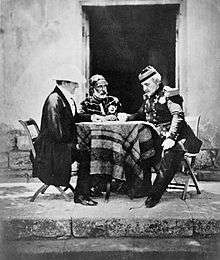
Past Albert Street, more mills were built on the northern side and more streets of small terraced houses on the southern side. The old streets were named after characters and events in the Crimean War (1853–1856) which was occurring at that time.[1] These include Raglan Street (named after Lord Raglan, commander of British forces in the Crimean War), Garnet Street (after Garnet Wolseley, 1st Viscount Wolseley), Alma Street (after the Battle of Alma), Balaklava Street (after the Battle of Balaklava), Inkerman Street (after the Battle of Inkerman), Sevastopol Street (after the Siege of Sevastopol), Plevna Street (after the Siege of Plevna), and Varna Street (after the Siege of Varna). There were also streets named after Balkan places such as Bosnia Street, Balkan Street, Roumania Street and Servia Street, as well as Omar Street (possibly after Omar Pasha). Other streets were named after contemporary political and royal figures such as Peel Street (after Robert Peel) and Albert Street (named after Prince Albert).[12]
These street names are recalled in the collection of poetry The Irish for No by Ciaran Carson. In one of the poems entitled The Exiles’ Club, Carson imagines a group of Belfast exiles:
- After years they have reconstructed the whole of the Falls Road, and now
- Are working on the back streets: Lemon, Peel and Omar, Balaclava, Alma.[13]
All of these houses have now been demolished and replaced with modern terraced houses.
Schools
At the foot of Divis Street is located the Millfield campus of Belfast Metropolitan College, the largest further and higher education college in Northern Ireland. Nearby was located the original St. Mary's Christian Brothers' Grammar School. In the 1960s, this school transferred to a greenfield site on the Glen Road in the upper Falls.[14] The original school building is now the home of the Edmund Rice Schools Trust. Opposite is St. Mary's Primary School. Nearby is the location of the Árd Scoil which was historically the centre for Irish language and culture in the area. Just past it was located the Hastings Street RUC station.
There are currently two other primary schools in the Lower Falls district. These are St. Peter's[15] on Ross Road and St. Joseph's[16] on Slate Street. In addition, there is the Irish language Gaelscoil an Lonnáin at the top end of Leeson Street. Several older schools closed in the late twentieth century due to declining student numbers. These include St Finian's and St Gall's primary schools which were run by the De La Salle Christian Brothers. St Comgall's Public Elementary School, in Divis Street, opened in 1932 but closed in 1988.[17] St. Brendan's Primary School on nearby Milford Street closed in the 1960s but for two years housed some pupils from St. Mary's Christian Brothers' Grammar School which at that time had exceeded its capacity in its Barrack Street premises.
The Dunlewey Centre[18] is located near Gaelscoil an Lonnáin. The building was originally the home of the Bon Secours Sisters and also housed St. Vincent’s Primary School for Girls. It is a now the home of a community education centre.[19] Dunlewey Street on which it is located is named after the residence of a local mill owner, William Ross, who owned a house in Dunlewey, County Donegal. The nearby Ross Street is also named after William Ross.[20]
Churches

Historically, the Falls Road district has had a strong Roman Catholic tradition. This is reflected in the number of Catholic churches in the area. These include St Peter's Cathedral in the Lower Falls area just off Albert Street. This was originally a parish church built for the expanding Catholic population in the area in the 1860s. It was designed by Fr Jeremiah Ryan McAulay,[21] who had trained as an architect before he became a priest, and built on a site donated by a local baker, Bernard Hughes. It became the cathedral church for the Roman Catholic Diocese of Down and Connor and the episcopal seat of the Bishop of Down and Connor in 1986. It is home to St Peter's Schola Cantorum (Choir).[22][23]
Clonard monastery,[24] the home of the Redemptorist religious order, is located nearby. Father Alec Reid who played an important role in the Northern Ireland peace process was based here.
There were also several Protestant churches in the area. These have either been demolished or converted into other uses as their congregations dwindled with the building of the peace lines. These churches included the Methodist church in Divis Street (1850-1966)[25] which was designed by Charles Lanyon and was the original home of the Falls Road Orange Lodge. Nearby was the Hungarian Flour Mill owned by Bernard Hughes. It burned down in a fire in 1966.[26] There was also a Presbyterian church in Albert Street (1852-1972) where one of the ministers was the Rev. Henry Montgomery who helped establish the Shankill Road Mission in 1896.[27] St. Luke’s Church (1863-2006) on Northumberland Street, was the Church of Ireland church for the Lower Falls. It amalgamated with St. Stephen’s Church on Millfield.[28] St Philip's Church of Ireland Church (Drew Memorial) (1870-1994) on the Grosvenor Road merged with St. Simon's Church on the Donegall Road.[29]
Leisure and entertainment facilities
The Falls Leisure Centre is located in the lower Falls district. It currently offers a range of leisure facilities including a swimming pool, sauna and steam rooms, a gym, and a badminton court.[30] It was originally the location of the Falls Public Baths where local residents could avail of washing and swimming facilities.[31] On 16 April 1941, it was the site of a temporary morgue following the Belfast Blitz.[32] This is described in the novel The Emperor of Ice-Cream by the novelist Brian Moore.
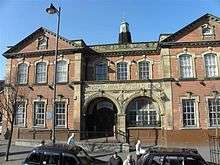
The Lower Falls area previously had many linen mills. These have either been demolished or converted for other purposes. One of these is Conway Mill, in Conway Street (named after the Conway family, a noted generous family of the Clonard area). Originally a flax spinning mill, it now houses a community enterprise of small businesses, art studios, retail space and education floor.[33][34] It also houses the Irish Republican History Museum.
One of three Carnegie libraries built in Belfast is situated in the lower Falls Road. It opened on 1 January 1908 and is the last Carnegie library in Belfast still functioning as a library.[35] Opposite was located the Clonard Picture House which closed in 1966.[36] The Diamond Picture House at the corner of Cupar Street closed in 1959.[37] The Arcadian cinema on Albert Street opened in 1912 but closed in 1960.[38]
At the junction with Grosvenor Road is located Dunville Park[39] which was first opened in 1893. It was funded by Robert G Dunville, the owner of the nearby Dunville Whiskey distillery.[40] who also funded the large fountain at the centre of the park which was designed by the Scottish designer Arthur Ernest Pearce.[41] The park has recently been refurbished and includes football pitches. Robert Dunville not only gave his name to the park and the adjacent street but named another street after his daughter Sorella.[42]
A strong working class community, the Lower Falls has a history of storytelling, music and song which was often enjoyed in the many public houses in the area.[43] These included such establishments as the Old House, McGeowns, the West End Bar, the Laurel Leaf, the Centre Half and Haughey's. Gerry Conlon, who grew up in Peel Street, recalled in his autobiography Proved Innocent how he could see several pubs just a few yards from his front door: I’d watch the men off to the pubs. There were three pubs, Paddy Gilmartin’s which was called the Laurel Leaf, Peter Murray’s [the West End Bar] directly opposite, or further down on the right-hand side was Charlie Gormley’s, across from Finnegan’s the butcher shop.[44] The Centre Half Bar which was located at the corner of Panton Street and the Falls Road was named by the licensee Mickey Hamill who played for both Belfast Celtic and Glasgow Celtic as well as Manchester United and Manchester City. He captained the Ireland team to their first Home International championship win in 1914.[45] Most of these bars were demolished as part of the redevelopment of the area which occurred in the 1970s and 1980s.
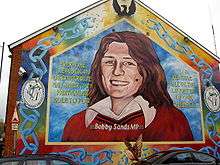
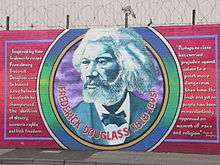
Murals
On some walls along the main road have been painted large murals. These are representations of local and national political issues and figures. One of the most famous is the large mural of Bobby Sands on the side wall of Sinn Féin's offices at the corner of Sevastopol Street. Further down the road on the corner of Northumberland Street is a series of murals which has come to be called the International or Solidarity Wall. This is a series of images of international figures who have been involved in various liberation struggles. These murals have become a popular attraction for visiting tourists.[46]
Middle Falls
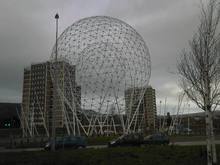
This section of the road centres on the Beechmount district and stretches from the intersection with the Grosvenor Road/Springfield Road to the Whiterock Road. The district takes its name from Beechmount House which was located at the top of a nearby hill surrounded by beech trees.[47] It was the former home of Eliza and Isabella Riddel. It is now the site of an Irish Language school.
The Whiterock Road leads to the Ballymurphy and to Turf Lodge districts. It also leads to the Black Mountain which forms part of the range of hills overlooking Belfast. Across the Falls Road from the Whiterock Road is the Donegall Road. This road leads down to the junction with Broadway and Westlink – M1 motorway and then on down to Shaftesbury Square in the city centre. At the junction with Westlink is located the large public sculpture formally called RISE but informally known as the balls on the Falls.
Through the area flowed the Clowney Water or River (Irish An Chluain)[48] which is a tributary of the larger Blackstaff River. Both have largely been covered over and piped in.[49]
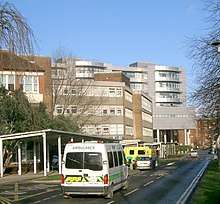
Hospitals
There are several large hospitals in the area including the Royal Victoria Hospital, the Royal Jubilee Maternity Service, the Royal Belfast Hospital for Sick Children (Children's Hospital), and the Royal Dental Hospital[50] These four linked hospitals make up Northern Ireland's biggest hospitals complex. The Royal Victoria Hospital treats over 80,000 people as inpatients and 350,000 people as outpatients every year. The complex is a major training site for medical, dental, nursing and other health students from Queen's University Belfast.[51] The original hospital opened in 1797 and moved to its present site in 1903.[52] The hospital was designed by Henman and Cooper of Birmingham in 1899, completed in 1906. It was claimed to be the first air-conditioned public building in the world.[53]
Opposite the Children's Hospital is Mulholland Terrace, a row of terraced houses which were built in the nineteenth century by David Mulholland. He also owned several bars in the area.[54]
Schools
There are also a number of educational institutions in the immediate area. At the senior level, there is St Dominic's Grammar School for Girls. Beside it was located St. Catherine's Primary School which was also run by the Dominican nuns but closed in 2005. At the rear was located St Rose's High School in the Beechmount district which in 2019 was amalgamated with the Christian Brothers School, Glen Road and Corpus Christi College to form All Saints College / Coláiste na Naomh Uile.[55]
There were several boys secondary schools in the area which have gone through a process of merging over the past forty years. St. Thomas’s Boys Secondary School on the Whiterock Road opened in 1957. St. Peter’s Boys Secondary School on Brittons Parade opened in the 1960s. In 1988, both of these schools amalgamated with Gort na Móna Secondary School to become Corpus Christi College which in turn merged (see above). St. Thomas's had a strong literary heritage. For a period, its headteacher was the writer Michael McLaverty. In addition, Seamus Heaney taught here for a while in the 1960s.[56] [57] He references the area in one of his poems:
- Is there life before death? That's chalked up
- In Ballymurphy. Competence with pain,
- Coherent miseries, a bite and a sup,
- We hug our little destiny again.[58]
Brendan Hamill, another writer, who attended the school in the 1960s recalled later: While on teaching practice, Seamus Heaney came to St Thomas’ about October that year (1962). I remember him, his voice grave and resonant, his big, brown shoes, reading from Carrickfergus by Louis MacNeice. He was an enormously decent man with extraordinary antennae.[59] Joe Graham, the writer and historian, was also a student at the school when McLaverty was the headteacher. For several years, after the school closed, this building was used by Belfast Metropolitan College for further education courses. After the new Springvale campus of the college was opened the building was demolished.[60] Coláiste Feirste is an Irish language school situated in the Beechmount district. .
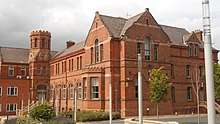
St. Paul's Primary School is also located in the Beechmount area.[61] There are two Irish language primary schools. These are Gaelscoil na bhFal and Bunscoil an tSléibhe Dhuibh.[62]
At the higher education level, there is St Mary's University College which is part of Queen's University Belfast. This was established in 1909 as St Mary's Training College to train women as teachers. It amalgamated with St Joseph's Training College (for male trainee teachers) in 1985. Besides teacher training it now offers a range of degree courses.[63] The college has a substantial programme of community engagement playing host to many local events including many organised by Féile an Phobail.[64]
Churches
St Paul's Church is located opposite the hospitals on the corner of Cavendish Street. It was built as a chapel of ease to St Peter's Cathedral and celebrated its first Mass in July 1887.[65] St.Paul's was raised from "a district of St Peters" to the status of a parish in 1905.[66]
Recreation and culture
Near Beechmount is located Willowfield Park which has a number of playing fields.[67] It is located on the site of the Willowbank Huts which in the late nineteenth century housed a small British Army barracks. When the huts were vacated they were used by various groups including Fianna Éireann.[68] Corrigan Park which is a facility for Gaelic games is located on the Whiterock Road. A nearby smaller facility for various sporting activities is McCrory Park.[69] It was named after Cardinal Joseph MacRory who was Bishop of Down and Connor and then Primate of All Ireland in the early part of the twentieth century. During the 1970s it was occupied by the British Army who called it Fort Pegasus. The Whiterock Leisure Centre is located off the upper Whiterock Road. It has a community garden and allotment site. Developments include a playground and multi-use games area.[70]
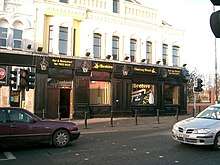
Historically, there has been a continuing interest in the Irish language and culture in the area. In 1936 the Cluain Árd centre was established in the Beechmount area and became a centre for Irish language enthusiasts.[71] In the 1960s, there was a resurgence of interest in the Irish language reflected in the development of the Shaw's Road Gaeltacht in Andersonstown. Since then, interest has grown, with the approval by Belfast City Council of a Gaeltacht Quarter around the Falls Road in 2002. The Cultúrlann McAdam Ó Fiaich, known colloquially as the Cultúrlann, is an Irish language and arts centre based in the middle Falls area which opened in 1991. It was originally the home of Broadway Presbyterian church.[72] The centre also houses the Irish language bookshop An Ceathrú Póilí.[73] The Féile an Phobail, an annual festival of Irish culture, which was established in 1988 provides a showcase for Irish culture.[74] Nearby, at the corner with Broadway, is the new Áras na bhFál, the home of Iontaobhas na Gaelscolaíochta - the Trust Fund for Irish-Medium Education.[75][76]
The Áras Uí Chonghaile/James Connolly Visitor Centre is located near the top of the Donegall Road. This centre is dedicated to the life and work of James Connolly who lived nearby for a period in the early years of the twentieth century.[77]
There are some large bars in the middle Falls area. These include the Beehive and the Rock Bar.
The Broadway Cinema which was situated near Beechmount was the largest of Belfast's suburban cinemas when it opened in 1936. It closed in 1972 after a bombing.[78] On the Donegall Road, is the former site of Celtic Park. This was originally a football stadium and the home of Belfast Celtic F.C.. It was also the first greyhound racing track to open in Ireland.[79] The stadium closed in 1983 and is now the site of a shopping centre.
Upper Falls
This section stretches from the Whiterock Road to the Andersonstown Road. As its name implies, the Andersonstown Road leads to the Andersonstown district and the on out of the city. At the junction with the Glen Road was located the Andersonstown RUC station which was the most attacked police station in Northern Ireland. It was closed and demolished in 2005.[80] The Glen Road runs for almost three miles passing the junction with Monagh By Pass/Kennedy Way, then Shaw's Road and Suffolk Road until it changes name to Colinglen Road. For much of the route in forms the northern boundary of Andersonstown and then Lenadoon.
Schools
St. Louise's Comprehensive College which was one of the largest girls schools in Europe with over 2,000 pupils is located in this area.[81] In 2019, it was decided to admit boys and to reduce the overall student numbers to 1500.[82] Nearby is located St. Kevin's Primary School which was established in 1933.[83] There is also the St. Maria Goretti Nursery School on the Whiterock Road.[84]
Churches
The St. John’s RC Church is located near the foot of the Whiterock Road.[85] It was originally established in 1928 as the population of the area increased. St. Matthias's Church is located on the Glen Road not far from Milltown Cemetery. It was originally a Church of Ireland church from 1892 - 1969.[86] The church is now part of the parish of St Teresa of Ávila, the main church of which is located further up the Glen Road..

Recreation
In the Upper Falls area is located the Falls Park which was established in 1873.[87] The park has many mature trees, flower beds, horticultural displays and grassland areas. The park contains playing fields for Gaelic games and soccer. It has a 3G pitch, a bowling green and other facilities. Developments include an outdoor gym, a dedicated youth area suitable for a range of uses and a refurbished play park with modern play equipment.[88] In 1924, an outdoor swimming pool, known locally as The Cooler, was added to the park. The pool closed in 1979 for public health reasons.[89] The Féile an Phobail has its closing concert here each year.
Opposite the Falls Park, on Milltown Row, are located the facilities of St. Gall's GAC. Further up the Falls Road is located The Felons, a large social club and restaurant. It is located on the site of a former Methodist meeting house.[90]
Cemeteries
_-_geograph.org.uk_-_811787.jpg)
In the late 19th century, with the rapid increase in the city population, there was an increasing need for cemeteries. At that time, the Upper Falls was a rural area and the city council and the Catholic Church decided to buy large spaces in the area to create cemeteries. The Belfast City Cemetery which is located at the bottom of the Whiterock Road, is a municipal cemetery maintained by the Belfast City Council and is one of the largest burial sites in the city. It opened in 1869.[91] At the junction with the Glen Road, is located Milltown Cemetery, maintained by the Catholic Church, which opened in the same year.
At the bottom of Milltown Cemetery is the Bog Meadows, a large wild life preserve.
Transport
.jpg)
Originally there was a tram service providing public transport on the Falls Road. This was introduced in the late 19th century and replaced by trolleybuses in 1938. There were three routes along the road: 11 for Falls Road-Whiterock Road, 12 for Falls Road-Andersonstown Road and 13 for Falls Road-Glen Road. The 77 route from the Gasworks to the Waterworks ran via Albert Street/Northumberland Street and cut across the Falls Road and the Shankill Road.[92] The trolleybuses were replaced by diesel buses in the 1960s. With the outbreak of the troubles, the bus service was withdrawn. The gap in public transport was replaced by black taxis. Since the troubles ended, the public bus service has been re-introduced and expanded. Metro, a division of Translink now operates the bus service. The Falls Road is designated one of the quality bus corridors (QBCs) within the city with a variety of different routes.[93]
In 2018, the Glider bus service was introduced. It provides a service from Poleglass via the Falls Road-City Centre and Newtownards Road to Dundonald. It was the first cross-city bus service.
Politics
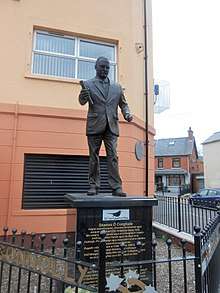
A predominantly working-class community, the Falls Road has historically had a strong socialist tradition, and, prior to the 1970s, had been less Irish nationalist than other areas of Northern Ireland. James Connolly resided in the Upper Falls for a period in the early 20th century and was involved in organising the workers[94] but the area was generally seen as a bedrock of the Irish Parliamentary Party (IPP) at the time. Éamon de Valera standing for Sinn Féin lost heavily standing in the Falls constituency in the 1918 UK General Election to the IPP's Joe Devlin. Connolly's secretary Winifred Carney also lived on the Falls with her husband, George McBride, a Protestant and World War I veteran. She is buried in Milltown Cemetery.
The past century has seen an ongoing contest between various versions of labour/socialist and nationalist/Irish republican for electoral leadership in the area. In the 1929 election to the new Parliament of Northern Ireland, the Belfast, Falls constituency was won by the Nationalist Richard Byrne after a bitter contest with William McMullen, a supporter of Connolly.[95]
In the 1945 election, Harry Diamond won the seat standing for the Socialist Republican Party. He held the seat until 1969 when he was defeated by Paddy Devlin standing for the Northern Ireland Labour Party. Devlin, who had once been a member, alongside Diamond, of the Belfast branch of the Irish Labour Party, became a founding member of the Social Democratic and Labour Party in 1970 and remained a member until Parliament was prorogued in 1972.[96]
In 1964, Billy McMillen stood as a Republican Clubs candidate for the Belfast West constituency in the Westminster election. His office was in Divis Street and the Irish tricolour alongside the Starry Plough of Connolly's Irish Citizen Army was displayed in the window. The Flags and Emblems Act gave the Royal Ulster Constabulary the power to remove any flag or emblem from public or private property which was considered to be likely to cause a breach of the peace. This was generally interpreted as any Irish flag since the Union Jack was specifically excluded from the Act.
Ian Paisley insisted the Royal Ulster Constabulary remove the Irish tricolour or he would organise a march and remove it himself. The police feared a backlash from Loyalists, and removed it, causing unrest and rioting by local residents.[97]
The Falls district is now one of seven wards within the Black Mountain (District Electoral Area) which elects seven councillors to Belfast City Council. In 2014, five Sinn Féin, one SDLP and one People Before Profit councillors were elected. The Falls Road forms the centre of the Belfast West (UK Parliament constituency). The Westminster seat has been held by various nationalist politicians since the 1960s. Paul Maskey of Sinn Féin was elected MP in 2011, but in line with Sinn Féin's abstentionist policy he has not actually taken the seat at Westminster. In the 2017 Northern Ireland Assembly elections, a total of four Sinn Féin and the same People Before Profit representative (Gerry Carroll) were elected in the Assembly constituency.
The Troubles
In the late 1960s, many Catholics from across Northern Ireland began to campaign, many with Northern Ireland Civil Rights Association (NICRA), against discrimination in housing and jobs, under the banner of a civil rights campaign, in conscious imitation of the philosophy of, and tactics used by, the American Civil Rights Movement.[98]
Many Unionists saw NICRA as an Irish republican Trojan horse, designed to destabilize Northern Ireland, and force unionists into a united Ireland.[99][100] Several streets around the Falls Road were burnt out by loyalists in August 1969.[101] In response to the worsening situation, the British Government deployed the British Army on the Falls Road. The troops were initially welcomed by many but not all Falls residents to protect them, but heavy-handed tactics by the mostly British-born members of the Army who did not know, care or understand the situation would estrange most Catholics and nationalists.[102][103]
In 1970, the road was the scene of what became known as the Falls Curfew. 3,000 British troops sealed off the streets around the Falls Road, home to about 10,000 people, setting off 1,600 canisters of CS gas.[104] The British actions were opposed by the Official IRA (OIRA), who engaged them in a vicious gun battle. Over the course of the weekend, four Catholic civilians were killed by the British Army. Ninety rifles were recovered.[105] This is widely regarded as the end of the British Army's "honeymoon" period with nationalists in Belfast.[106]
During the Troubles there was repeated sectarian attacks by loyalists on residents of the Falls Road.[101] These attacks increased during the 1969 Northern Ireland riots when whole streets in the Falls Road area were destroyed by loyalists from the Shankill Road area. Loyalists paramilitaries killed many local residents. Temporary barricades were constructed to provide residents with some security. These developed into peace walls which today separate the Falls Road from the neighbouring Shankill Road. Although the troubles have now ceased, the peace walls still exists in this so-called Interface area.
For the following three decades, the British Army maintained a substantial presence on the Falls Road, with a base on top of the Divis Tower. This was removed in August 2005 as part of the British government's normalisation programme, following the Provisional Irish Republican Army's statement that it was ending its armed activities. In the intervening period, the Falls Road area saw some of the worst violence of "the Troubles". The last British soldier to be killed on the road itself was Private Nicholas Peacock, killed by a booby trap bomb left outside the Rock Bar, opposite the top of the Donegall Road.[107]
In 1991 IRA hit squads based in the Upper Falls and Beechmount were involved in attacks against loyalist paramilitaries in the nearby Village area. In September 1991, they shot dead 19-year-old UVF member John Hanna at his home on the Donegall Road, and in November the same year, they shot dead William Kingsberry and his stepson, Samuel Mehaffey, members of the UDA and RHC respectively, in their home on Lecale Street.[107]
Literary and musical references
There are many literary references to life on the Falls Road. These include:
- Gerry Adams (1982). Falls Memories. Dingle:Brandon.
- Ciaran Carson (1997). Star Factory. London: Granta Books.
- Liam Carson (2010). Call Mother a Lonely Field. Bridgend: Seren.
- Eimer O'Callaghan (2014). Belfast Days. A 1972 Teenage Diary. Sallins: Merrion Press.
- Patricia Craig (2007). Asking for Trouble. Belfast: Blackstaff.
The American singer Nanci Griffith sings in her song It’s a hard life wherever you go which she wrote in 2002:
- I am a backseat driver from America
- They drive to the left on Falls Road
- The man at the wheel's name is Seamus
- We pass a child on the corner he knows
- And Seamus says, Now, what chance has that kid got?'
- And I say from the back, 'I don't know.'
- He says, 'There's barbed wire at all of these exits
- And there ain't no place in Belfast for that kid to go.'[108]
See also
References
- PlaceNames NI: Falls
- Language/Cultural Diversity – Irish Department of Culture, Arts and Leisure Archived 7 November 2012 at the Wayback Machine, dcalni.gov.uk; accessed 30 March 2015.
- Belfast History, rushlightmagazine.com; accessed 30 March 2015.
- "Old Pound Loney". Retrieved 9 December 2016.
- "S.Mary's Hall, Belfast". archiseek. Retrieved 22 June 2020.
- "10 of Britain's best listed supermarkets". the spaces. Retrieved 23 June 2020.
- Old Ordnance Survey Maps:The Falls 1931. Gateshead: Alan Godfrey. ISBN 0 85054 247 2.
- "Memories of old St.Peters". Belfast history. Retrieved 24 June 2020.
- "Belfast History". Rushlight. Retrieved 24 June 2020.
- Roy, Megan (2007). "Divis Flats". Iowa Historical Review. 1 (1): 1–44. Retrieved 27 June 2020.
- "1969 - Divis Flats, Belfast". archiseek. Retrieved 22 June 2020.
- Old Ordnance Survey Maps:The Falls 1931. Gateshead: Alan Godfrey. ISBN 0 85054 247 2.
- Carson, Ciaran (1987). The Irish for No. Dublin, Ireland: Gallery Books. ISBN 1 85235 016 4.
- "St. Mary's Christian Brothers Grammar School, Belfast". Retrieved 12 November 2016.
- "St. Peter's Primary School, Belfast". Archived from the original on 12 March 2017. Retrieved 10 March 2017.
- "St. Joseph's Primary School, Belfast". Retrieved 10 March 2017.
- "St. Comgall's School". 28 Days Later. Retrieved 25 February 2020.
- "Dunlewey Centre Belfast Belfast". Retrieved 6 November 2016.
- "New Start Centre". Retrieved 14 February 2020.
- "Memories of St. Peters". Belfast History. Belfast history. Retrieved 26 February 2020.
- "1866 – St. Peter's Cathedral, Belfast". Archiseek. Retrieved 22 June 2020.
- "St. Peter's Cathedral". Retrieved 2 October 2016.
- "visit St Peter's Cathedral". Retrieved 12 January 2020.
- "Clonard Monastery". Retrieved 2 October 2016.
- "Falls Road Methodist Church". Retrieved 2 October 2016.
- "1884 - Hungarian Flour Mill". Archiseek. Retrieved 20 March 2020.
- "Rev. Henry Montgomery". Retrieved 2 October 2016.
- "St. Stephen's Church". Retrieved 5 July 2019.
- "Church of Ireland churches". Retrieved 5 July 2019.
- "Falls Leisure Centre". Retrieved 28 December 2019.
- "Going for a swim at the Falls Baths". Retrieved 28 December 2019.
- "Falls Road Baths". Retrieved 28 December 2019.
- "Conway Mill". Retrieved 6 November 2016.
- "History of Conway Mill". Culture Northern Ireland. Retrieved 15 August 2020.
- "Catalogue of the Photographic Exhibition of Irish Carnegie Libraries" (PDF). An Chomhairle Leabharlanna (Library Council of Ireland). Retrieved 4 September 2012.
- "Clonard Picture House". Cinema Treasures. Retrieved 17 March 2020.
- "Diamond Picture House". Cinema Treasures. Retrieved 17 March 2020.
- "Old Cinema Memories". The Vacuum. Retrieved 15 August 2020.
- "Dunville Park, Belfast". Retrieved 12 November 2016.
- "Dunville Park - Belfast City Council". Retrieved 5 July 2019.
- "Arthur Edward Pearce". Retrieved 5 July 2019.
- "Memories of St. Peters". Belfast History. Belfast History. Retrieved 26 February 2020.
- Adams, Gerry (1982). Falls Memories: A Belfast Life. Dingle, Co. Kerry: Brandon. ISBN 0863220134.
- Conlon, Gerry (1990). Proved Innocent. London: Hamish Hamilton.
- Law, Gary (2008). Historic Pubs of Belfast. Belfast: Appletree Press.
- "Murals" (PDF). Archived from the original (PDF) on 26 July 2011.
- "Beechmount". Retrieved 14 February 2020.
- "Logainm.ie". Retrieved 17 March 2020.
- "Map of Belfast's past". Map of Belfast's past. Irish Echo. Retrieved 26 February 2020.
- "Royal Victoria Hospital, Belfast". Retrieved 12 November 2016.
- "Royal Victoria Hospital". Retrieved 15 February 2020.
- "1903 - Royal Victoria Infirmary, Belfast". archiseek. Retrieved 22 June 2020.
- "Historic Hospitals - Northern Ireland". Retrieved 15 February 2020.
- "ancestry,co Mulholland". Retrieved 28 March 2019.
- "Edmund Rice Schools Trust - ALL SAINTS COLLEGE / COLÁISTE NA NAOMH UILE". Retrieved 30 December 2019.
- "The Write Off". Retrieved 15 February 2020.
- "Literary geniuses side-by-side in staff-room of local school". Retrieved 14 February 2020.
- Heaney, Seamus (1975). North. London: Faber & Faber. p. 60. ISBN 057110813X.
- "Literary geniuses side by side". Best of the West 2020. Belfast Media Group. Retrieved 27 February 2020.
- "LANDS, & BUILDINGS AT THE FORMER WHITEROCK CAMPUS,". Property Pal. Retrieved 6 March 2020.
- "St. Paul's Primary School, Belfast". Archived from the original on 12 March 2017. Retrieved 10 March 2017.
- "Gaelscoileanna". Gaelscoileanna. Retrieved 6 March 2020.
- "St. Mary's University College". Retrieved 15 February 2020.
- "Events hosted by the College". St. Mary's University College, Belfast. Retrieved 18 March 2020.
- "Irish News". Retrieved 14 February 2020.
- "St. Paul's Church, Belfast". Belfast Forum. Retrieved 9 March 2020.
- "Willowbank Park". Sports pitches. Belfast City Council. Retrieved 26 February 2020.
- "1916 Trail leaflet" (PDF). Visit West Belfast. Visit West Belfast. Retrieved 26 February 2020.
- "McCrory Park". Retrieved 14 February 2020.
- "The Falls Masterplan". Belfast City Council. Retrieved 6 March 2020.
- Anraí Mac an Ultaigh, Anraí Mac an Ultaigh (2019). Seal S’Agamsa. Baile Átha Cliath: Coiscéim.
- "Culturlann Belfast". Retrieved 2 October 2016.
- "Independent Bookshops: A UK Guide — Independent bookshops in Northern Ireland". 1 October 2011. Retrieved 30 May 2017 – via The Guardian.
- "Feile Belfast". Retrieved 9 December 2016.
- "Áras na bhFál, Falls Road". Paul McAlister, Architects. Retrieved 16 May 2020.
- "Trust Fund for Irish-Medium Education". Iontaobhas na Gaelscolaíochta. Retrieved 23 May 2020.
- "Áras Uí Chonghaile The James Connolly Visitor Centre". Áras Uí Chonghaile The James Connolly Visitor Centre. Retrieved 26 February 2020.
- "Broadway Cinema". Cinema Treasures. Retrieved 17 March 2020.
- "Belfast Celtic". Groundtastic. Archived from the original on 28 August 2008. Retrieved 11 February 2009.
- "End of a west Belfast emblem". Irish Times. 29 January 2005. Retrieved 6 March 2020.
- "'She was the only man on the Falls Road'". Retrieved 12 November 2016.
- "St Louise's Comprehensive College in Belfast will now admit boys". Retrieved 30 December 2019.
- "St. Kevin's Primary School, Belfast". Retrieved 9 November 2019.
- "St. Maria Goretti Nursery School". St. Maria Goretti Nursery School. Retrieved 16 February 2020.
- "St. John's Falls Road". Retrieved 9 December 2016.
- "History". St. Matthias's Church. Retrieved 30 March 2020.
- "Falls Park, Belfast". Retrieved 12 November 2016.
- "Falls Park". Belfast City Council. Belfast City Council. Retrieved 26 February 2020.
- "Falls Park". Retrieved 14 February 2020.
- "In the club". The Guardian. 6 August 1999. Retrieved 6 March 2020.
- "Belfast City Cemetery". Retrieved 12 November 2016.
- "Old cinema memories". The Vacuum. Retrieved 15 August 2020.
- "Translink". Metro is Belfast. Retrieved 27 March 2020.
- Donal Nevin. James Connolly. A Full Life; (Dublin, 2006, Gill & Macmillan); ISBN 0717129624
- Michael Farrell, Northern Ireland: The Orange State
- Connal Parr (2012): Managing His Aspirations: The Labour and Republican Politics of Paddy Devlin, Irish Political Studies, 27:1, 111-138
- Peter Taylor. Loyalists; ISBN 0-7475-4519-7, p. 32
- Weiss, Ruth. Peace in Their Time: War and Peace in Ireland and Southern Africa. p. 34.
- Lord Cameron, Disturbances in Northern Ireland: Report of the Commission appointed by the Governor of Northern Ireland (Belfast, 1969)
- Purdie, Bob. Politics in the Streets: the origins of the civil rights movement in Northern Ireland, The Blackstaff Press; ISBN 0-85640-437-3.
- Michael McCann. Burnt Out. How the Troubles began; (Cork, 2019, Mercier); ISBN 1781176191
- bbc.co.uk; accessed 31 March 2015.
- cain.ulst.ac.uk; accessed 31 March 2015.
- Dillon, Martin (1991). The Dirty War. Random House. p. 232. ISBN 0-09-984520-2.
- Ed Moloney. A Secret History of the IRA; ISBN 0-14-101041-X, p. 91.
- Richard English. Armed Struggle (2003), p. 136
- McKittrick, Feeney, Thornton, Kelters, David, Brian, Chris, Seamus (2004). Lost Lives. Mainstream Publishing. pp. 1158, 1248, 1257–58.CS1 maint: multiple names: authors list (link)
- "Its a hard life chords". Ultimate Guitar. Retrieved 21 May 2020.
External links
| Wikimedia Commons has media related to Falls Road. |
